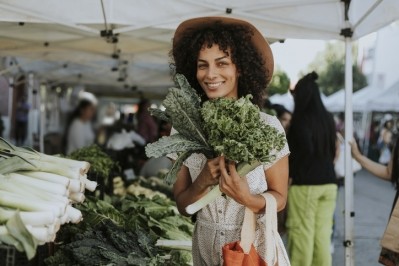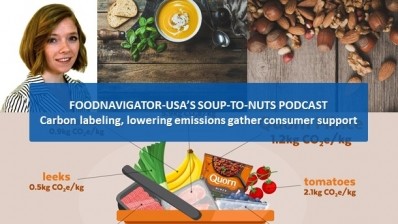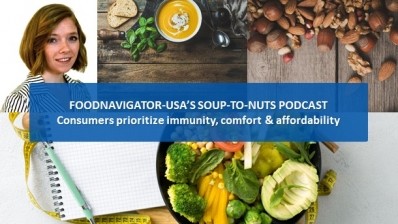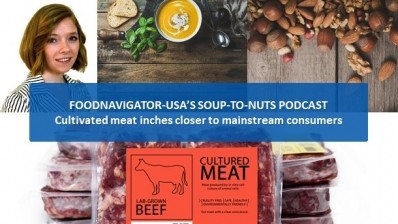Soup-to-Nuts Podcast: 3 sustainable alternatives to single-use plastic, EPS foam, paper packaging
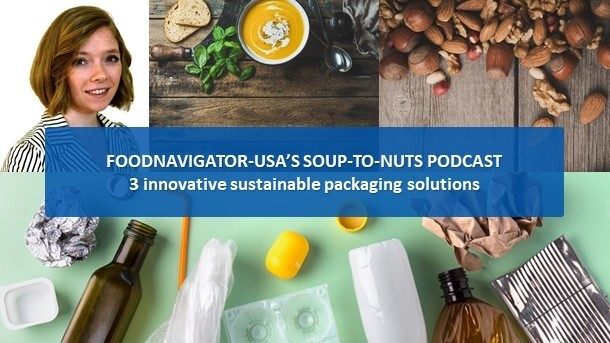
According to research conducted by the Consumer Brands Association, 87% of Americans before the pandemic said they worried about single-use plastics and 86% said the world was facing a packaging and plastic waste crisis. But when confronted with the lethal threat of the novel coronavirus in 2020, consumer tolerance increased for plastic, which many saw as a protective layer against COVID-19. As such, the percentage of Americans concerned about single-use plastic fell to 80% in 2020, according to CBA, which warned this “small retreat” could slow environmental progress if left unchecked.
For its part, the trade group has aggressively pursued improving the nation’s recycling system and encouraged 25 of the largest CPG companies to commit to increasing recyclable content, minimize packaging and reusing material. Of these companies, 80% intend to make all their packaging recyclable or compostable by 2030 at the latest.
At the same time, as consumers learn more about how COVID-19 is transmitted and they are confronted with mounting piles of packaging and litter from increased deliveries, their concern is swinging back towards the environment.
To help CPG companies meet this demand and their ambitious goals to reduce packaging waste, this episode of FoodNavigator-USA’s Soup-To-Nuts podcast features three emerging brands and participants in the Huhtamaki Circular Economy Startup Program by Food System 6 that offer solutions for more sustainable packaging without compromising quality, protection or production. They include SoluBlue, which has developed a sustainable seaweed-based alternative to plastic food packaging; Rhizoform, which uses increasingly popular and versatile mycelium to make an alternative to the plastic foam used in thermally insulated packaging; and Nafici Environmental Research, which converts agricultural residues into paper pulp with a patented low-carbon process.
[Editor’s note: Never miss another episode of FoodNavigator-USA’s Soup-To-Nuts podcast: Subscribe today.]
SoluBlue offers breathable plastic alternative
One of the most popular packaging options favored by CPG companies is plastic, but it also is one of the most problematic.
Most people have seen plastic waste threatening marine life, a wayward takeout bag snagged in a tree branch where it lingers for years or contended with its recyclability limitations. And while plastic is good at protecting finished products from outside elements, the chief technology officer of the startup SoluBlue warns it also can speed expiration of some fresh produce – contributing to a secondary problem of food waste.
Francis Field, who also helped co-found SoluBlue, explains the company’s seaweed-based, non-toxic, food grade plastic alternative solves for all these challenges.
“The problem with regular plastic is that fresh fruits and vegetables when they are packed, they’re still alive. So, they’re still breathing. They’re still respiring. They’re still releasing moisture. And when this is trapped in plastic packaging it causes condensation” that leads to mold, he said. “So, our solution is a new material … which is breathable and hydrophilic. And that means that the condensation doesn’t build,” which keeps the food fresher 250% to 400% longer.
SoluBlue’s solution also solves the problem of not knowing how or being able to recycle plastics contaminated with food – a challenge at both the consumer and manufacturing levels. Field explains that if contaminated plastic ends up in the waste stream because it is too dirty to recycle, it will compost within weeks. Similarly, it ends up in the recycle system where it doesn’t belong it will “fall out” during the washing phase when it gets wet – reducing the risk of contaminating the entire batch of plastic.
As a B2B business, SoluBlue is focused on partnering with incumbent companies that use plastic or produce plastic as an essential component of their product, but which they know they need to eliminate or drastically reduce.
SoluBlue is seeking food packaging partners to test and scale its product throughout the supply chain. Field explains that SoluBlue doesn’t want to manufacture packaging, but rather leave that with the experts so it can focus on the technology.
Rhizoform offers sustainable insulation
While plastic, and specifically single-use plastic, has become the posterchild for why more sustainable packaging options are needed, it is far from the only material earning consumers’ ire. Another often shunned, but difficult to replace material is extruded polystyrene foam – the light, insulating material often used in disposable coolers used to ship meal kits, seafood and other perishables that need to stay cold.
As an inexpensive, effective insulator, it is hard to beat EPS, but from an environmental perspective its impact has been devastating – a reality that Rhizoform founding member Ryan Peterson saw firsthand as an Alaskan fisher.
He explains that in his hunt to find a more sustainable shipping option to EPS for frozen fish, he teamed with other members of Rhizoform to develop the RhizoBox, which uses biodegradable mycelium for thermal insulation.
“We have sort of figured out a way to grow this mycelium through a food stock that also forms or that also serves as a kind of structural lattice, and in the end you get this board that looks and feels not too different from Styrofoam,” Peterson said.
When the foam has reached the end of its life, Peterson said, it will compost under non-industrial circumstances in about one year, and “you have really healthy soil.”
Using mycelium as an alternative to EPS isn’t entirely new. Peterson notes mycelium already is used as a protective packaging material, such as corner buffers when transporting furniture. But he says Rhizoform is the first to prove its insulative, waterproofing and anti-viral properties.
While Rhizoform has developed a minimum viable product, it continues to iterate its offering, which it is keeping at a relatively small scale for now. However, Peterson said the company is contacted “exponentially more and more” by companies large and small looking for sustainable insulation – demonstrating the need for and potential of a product like this one.
Nafici Environmental Research offers EcoPulping for more sustainable paper products
While paper and cardboard packaging are accepted more broadly by consumers and businesses alike because it is recyclable, the co-founder of Nafici Environmental Research Florence Miremadi-Nafice notes that the current process for making paper packaging isn’t perfect and as demand increases so is paper’s environmental impact under its current production process.
For example, she notes that some of the virgin wood pulp currently used to strengthen recycled paper packaging or to make virgin packaging comes from endangered forests and even when it comes from well managed forests it exacts a toll on the environment.
To help save the trees while still ensuring a sufficient supply of high-quality paper or fiber-based packaging, Nafici developed what it calls an EcoPulping, which is a patented low-carbon process that transforms agricultural residues that typically would be burned into paper pulp.
EcoPulping also can be done at a smaller scale closer to the agricultural site or production facilities, helping to reduce transportation related emissions.
The finished pulp is considered food grade and can be molded into bowls, plates and take-out containers or other packaging for CPG products.
SoluBlue, Nafici recognized for successful innovation
As participants in the Huhtamaki Circular Economy Startup Program by Food System 6, each of these companies worked closely with coaches, mentors and experts in their areas to advance their businesses. Based on their program participation and presentation at the end of the course, SoluBlue was tapped to receive $50,000 in funding to amplify its impact and Nafici Environmental Research was selected to receive $100,000 and one year of on-call custom support from Food System 6 to help it reach upcoming milestones.
